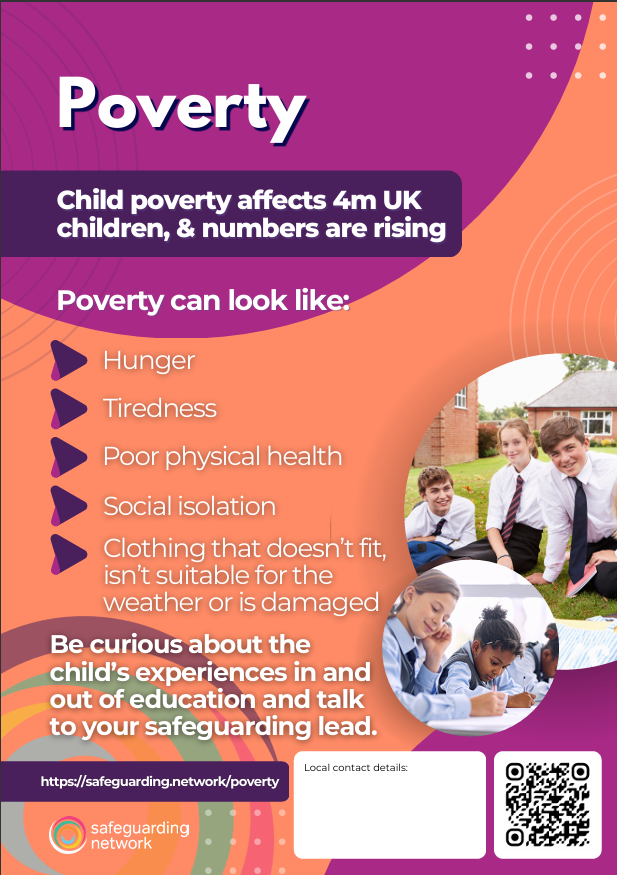Introduction
According to the latest parliamentary research on poverty in the UK, about 31% of children are living in relative poverty (after housing costs) and the number of people living in poverty is going to increase. Findings from a 2024 review by UNICEF into child poverty showed that child poverty levels have increased faster in the UK than in any of the 40 other high-income countries they looked at.
A child’s life chances are dependent upon a complex combination of household income, equality of opportunities and level of social inclusion. While some children who grow up in low-income households will go on to achieve their full potential, many others will not. Poverty places strains on family life, excludes children from the everyday activities of their peers and can lead to homelessness.
Tackling child poverty will help to improve children’s lives today, and enhance their life chances, enabling them to make the most of their talents, achieve their full potential in life and pass on the benefits to future generations.
Need more?
Thank you for visiting our resources pages. These are free to everyone as is our fortnightly safeguarding bulletin – general safeguarding information is too important to restrict. Become a member to access lots more, including training materials for you to deliver in-house on each topic in Keeping Children Safe in Education.
Sign up for FREE fortnightly bulletin.
What about training?
We can deliver training for your setting on this and other subjects via online platforms, or face-to-face in certain areas. Just get in touch to discuss your requirements.
Definition of poverty
There is no single definition of poverty. In the UK, there are two main ways that poverty is measured: the UK poverty line (based mainly on income) and the newer Social Metric Commission's poverty measure which considers other factors.
One definition is
"Individuals, families and groups in the population can be said to be in poverty when they lack resources to obtain the type of diet, participate in the activities and have the living conditions and amenities which are customary, or at least widely encouraged and approved, in the societies in which they belong."
Definition from Peter Townsend, sociologist and co-founder of Child Poverty Action Group
Prevalence
The following groups had the highest rates of relative poverty after housing costs in 2023/24:
- Working-age adults (43%) and children (62%) living in a family where nobody was in work
- People in social rented (40%) and private rented (37%) accommodation
- Children in families with three or more children (44%)
- People in families where someone is disabled (28%)
- People in Bangladeshi (53%) and Pakistani (47%) households
Figures from Poverty in the UK: statistics, House of Commons Library, April 2025
The latest annual report from the Joseph Rowntree Foundation highlights that the cost-of-living crisis is having a wide-ranging effect on poorer households and the situation is not improving over time. Some impacts identified in the report included the following:
- Over 8 in 10 low-income families with children (82%) were going without essentials in the 6 months to May 2025. This includes two thirds of families with children cutting back or skipping meals (66%) and almost 6 in 10 going hungry (57%) in the 30 days prior to the survey in May 2025.
- Two thirds of low-income families with children were in arrears with their household bills in May 2025 (66%), more than double the rate for families without children (27%).
If parents and carers are unable to afford the essentials such as utilities and food for their children, how do we expect children to thrive in education and become their best selves?
“I remember when my sister was just born…you have to keep the house warm. But you can't keep the house warm…because there was six of us in the house at the time…you're trying to feed everyone, keep everyone warm and then pay for every expense around the house, so it's quite a lot.” – Girl, 16.
“I would say some people don’t have a table…they can’t afford it, they might have to use the floor and sometimes the floor can be cold because of the heating.” – Girl, 10.
Poverty and safeguarding
Parents struggling to make ends meet can feel anger or sometimes guilt at the unfairness they see affecting their children. Most do a tremendous job of minimising the impact wherever they can, trying to ensure their children are well cared for and feel valued.
However, poverty can be a factor in children being at risk of harm due to the stresses it creates in families and the limitations it places on choice, even though it is not a safeguarding matter in itself. It can lead to safeguarding concerns such as:
- children’s basic needs not being met (food, warmth, clothing)
- social isolation
- the impact of stress within a household (including emotional abuse or domestic abuse)
- effects on learning and development
- the impact of long working hours (e.g., increasing strains on relationships, reducing the supervision of children)
- caring responsibilities
- poor self-esteem and emotional health issues (in child and/or parent)
- a risk of substance misuse (in child and/or parent)
Spot the signs
Organisations working with children and young people are in a key position to support them. Research shows that children and parents are unlikely to tell us what is happening, and it’s knowing the children and recognising changes in them that flags concerns in the first instance. For example:
- tiredness;
- persistent hunger;
- poor concentration;
- lower attainment;
- non-attendance on educational trips/involvement in educational activities where there is a cost;
- stress and/or anxiety.
What to do
Keep talking – maintain effective communication with students, be curious about their experiences both in and out of their education setting.
Create an open and approachable culture – help students think about the issues and attitudes behind poverty, particularly in relation to equality. Create aspiration and opportunity through high-quality teaching, while being aware of the limits and pressures on families, children and young people.
Consider how vulnerabilities might impact on individuals – think about the increased risk of exploitation and the barriers to attainment or the negative impact of increased instability. Be aware of the effects of child poverty and homelessness. Talk to children in advance about holiday periods and assess the risks of ‘holiday hunger’, loneliness and neglect. Recognise the stresses around key times of year, such as the commercial pressures around Christmas.
Consider avenues of support for students and families, including local early help processes. Signpost to support services, ensuring that this is through as many different routes as possible (e.g., leaflets, posters, conversations, etc.) and that information can be accessed discretely for those who might prefer this.
Take action - If you have concerns that a child may be being harmed or neglected, raise your concerns with your designated safeguarding lead and follow your safeguarding procedures.
Building partnerships with parents and carers
When working with parents and carers, practitioners should prioritise a child-centred approach, fostering partnerships to ensure understanding, support and safety.
Remember:
- Collaborative efforts are crucial, especially in cases of suspected harm.
- Practitioners must engage effectively with diverse families, demonstrating empathy, respect and cultural awareness.
- Communication should be clear, inclusive and accessible. Encouraging parental/carer involvement in decision-making and valuing their input is essential.
- Involving families and communities in designing processes fosters a holistic approach to safeguarding children.
- Continuous reflection and adaptation based on feedback from parents and carers enhance practice effectiveness.
- Have you considered if:
* the setting has inclusive ways for students and families to speak about homelife, so that experiencing poverty feels less stigmatised for all?
* the signposting and information regarding income and housing support is accessible to all families, with consideration given to language, literacy, learning needs?
* the setting always offers practical assistance to families impacted by poverty, where possible? This might be things like donated items to support hygiene and nutrition, clothing, toys or space and time on site for students to complete their homework somewhere warm.
FREE poverty poster
This free, downloadable resource raises the profile of safeguarding for your staff team. For use in staff rooms, on safeguarding boards or on the back of toilet doors, the poster includes tips, a space for local contact details, plus a link and QR codes to this resource page. Download the poster from the resources below.
DSL Training Materials
-

Homelessness and Poverty Handout
-

Homelessness and Poverty Presentation
-

Homelessness and Poverty Presenter Notes
-

Poverty Quiz
-

Poverty Quiz Answers
-

Poverty Scenario Early Years
-

Poverty Scenario Early Years - DSL Information Sheet
-

Poverty Scenario Primary and Secondary
-

Poverty Scenario Primary and Secondary - DSL Information
-

Poverty and homelessness Scenario (16+ settings)
-

Homelessness Scenario (16+ settings) - DSL Information Sheet
-

Poverty Whole Group Exercise
-

Poverty Whole Group Exercise - DSL Information Sheet
Resources
-

Poverty poster
-

Cost of the School Day Big Question
-

What's Poverty Like?
-

The Relationship Between Poverty and Child Abuse and Neglect: New Evidence
-

The cause of food bank use
-

State of Child Poverty
-

Empty plates and cold homes: What it’s like to grow up in poverty in 2024
-

UK Poverty 2025
-

Growing up in a low-income family: Children’s experiences
Save time and improve your safeguarding approach…
Bite-size training materials to share with your staff every month.
Support to explore and develop your safeguarding culture.
A huge array of resources and professional experience at your fingertips.
Get in touch now for a personal tour of the site and details of membership benefits.
We look forward to working with you.


